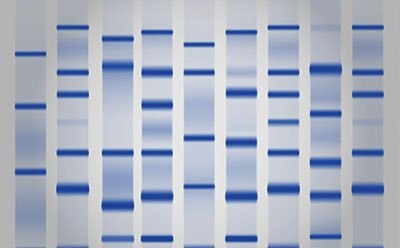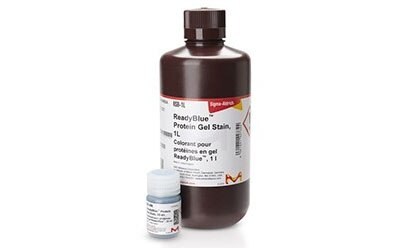Protein Electrophoresis Gel Stains
After separation by electrophoresis, protein bands are commonly visualized with gel stains. Utilizing either a dye-binding or color-producing chemical reaction, protein gel stains react selectively with proteins to yield a stained gel. Protein gel stains are typically selected based on the initial sample size, desired detection method, and compatibility requirements for downstream analysis.
Products
Fixing Solutions
After gel electrophoresis, proteins are typically "fixed" in the gel to prevent dispersion of the proteins prior to staining. Certain gel stains contain chemicals that obviate the need to fix gels prior to staining.
Colorimetric Protein Gel Stains
- Coomassie Brilliant Blue is used to stain proteins on polyacrylamide gels through electrostatic interactions with protein amino and carboxyl groups.
- ReadyBlue™ Protein Gel Stain is a rapid and sensitive colloidal Coomassie stain for polyacrylamide gels provided as a ready-to-use solution, allowing for a faster and simplified protocol. ReadyBlue™ can be imaged via colorimetric or IR fluorescence methods. This safe formulation contains no organic solvents or phosphoric acid and can be reused up to 3 times. Sensitivity down to 2 ng per band has been demonstrated with ReadyBlue™.
- EZBlue™ Gel Staining Reagent is a convenient, sensitive, and safe Coomassie Brilliant Blue G-250 colloidal protein stain that improves protein electrophoresis results while significantly reducing staining time. As a colloidal stain, it reacts only with proteins, not the gel itself. Background staining is reduced, so protein bands can be visualized almost immediately on polyacrylamide gels and PVDF membranes. No de-staining step is required, although a water wash may intensify bands and clarify the background. EZBlue™ reagent is extremely sensitive, detecting as little as 5 ng of protein.
- The Reversible Protein Detection Kit is a unique detection system designed for staining of proteins on nylon, nitrocellulose, and PVDF membranes or PAGE gels with the detection sensitivity similar to that of Coomassie stains. Most other stains produce high backgrounds on nylon membranes due to strong charge interactions with the membrane. Staining is easily reversible with an EDTA solution so that the blot can be reused for Western blotting or for amino acid sequence analysis.
- Naphthol blue black dye can be used to stain proteins on polyacrylamide gels, agarose gels, and nitrocellulose membranes. After electrophoresis, fixing the proteins in the gel is recommended. The gel is then stained with 0.1% Naphthol Blue Black in 7% (v/v) acetic acid for at least 2 hours and destained with a soluion of 7% (v/v) acetic acid. Detection sensitivity is approximately 20% that of Coomassie Blue
- Providing the highest sensitivity, the ProteoSilver™ Silver Stain Kit has a sensitivity of ≥0.1 ng of protein per band with an incubation time of 3-12 minutes. This stain is recommended for very low abundance proteins and is compatible with MALDI-TOF applications.
Fluorescent Protein Gel Stains
- EZFluor™ 1-step Fluorescent Protein Gel Stain is a ready-to-use fluorescent protein gel stain requiring only a single 5-30 minutes staining step without fixation and can detect as little as approximately 1-10 ng of protein per band. Staining is fully compatible with mass spectrometry and Edman-based sequencing.
- EZFluor™ UV 1-step Fluorescent Protein Gel Stain is a ready-to-use protein gel stain designed for imaging using a UV transilluminator and ethidium bromide filter compatible with mass spectrometry.
- SYPRO® Ruby protein gel stain is a ready-to-use, ultrasensitive, fluorescent stain for the detection of proteins separated by polyacrylamide gel electrophoresis (PAGE). This stain, designed especially for use in 2-D PAGE, has proven to be an excellent choice for 1-D PAGE and isoelectric focusing (IEF) gels as well. SYPRO® Ruby protein gel stain attains sensitivity comparable to many silver staining techniques.
- SYPRO® Orange is similar to SYPRO® Red, although it is somewhat brighter and gives slightly higher background fluorescence. The dye is efficiently excited by UV or broad band illumination. It is not suitable for staining proteins on blots or in IEF gels and shows reduced sensitivity when staining proteins on 2-D gels.
De-staining Reagents
- CoZap is used for rapid removal of Coomasie blue stain. The unique CoZap pad is placed directly into the de-staining tray and absorbs all free dye in solution, eliminating the need to change the de-staining solution.
Related Resources
- Protein Staining Reagents Selection Guide
Sigma offers EZBlue™ and ProteoSilver™ reagents for protein visualization, suitable for proteomics and traditional PAGE formats.
- Handbook: Protein Blotting Tips and Tricks
This handbook represents the collective experience of our application scientists, who are actively engaged in advancing the science of protein blotting and detection.
- Brochure: Rethink Western Blotting
Explore our products designed to improve each step of the Western blotting workflow.
To continue reading please sign in or create an account.
Don't Have An Account?
